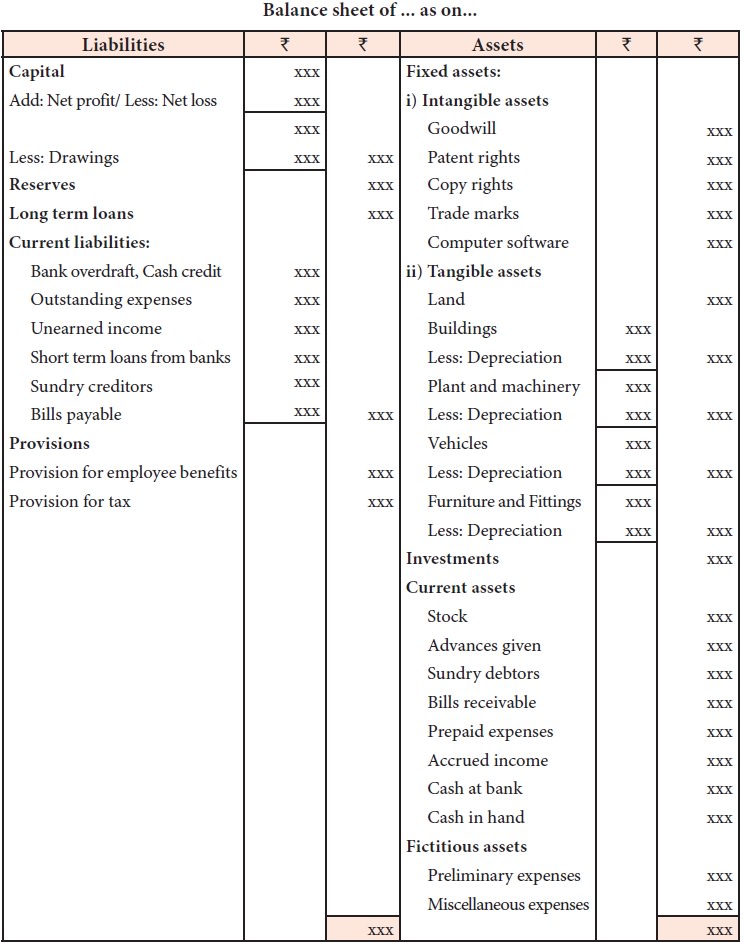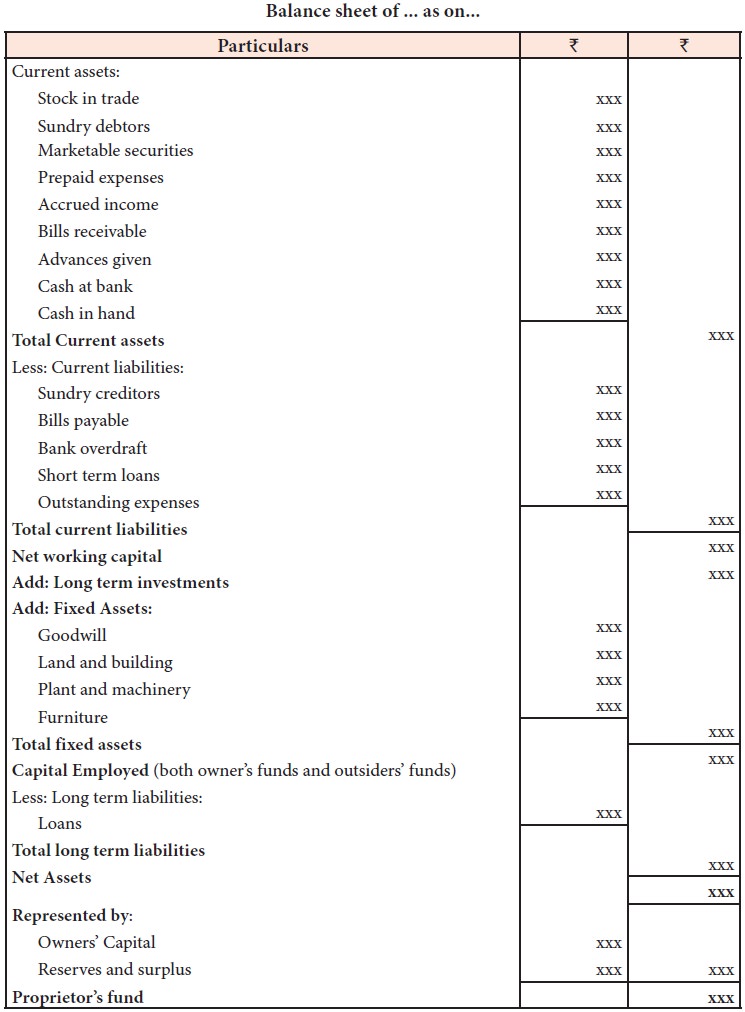Need for preparing, Methods of drafting, Preparation, Classification, Tutorial note | Accountancy - Balance sheet | 11th Accountancy : Chapter 12 : Final Accounts of Sole Proprietors - I
Chapter: 11th Accountancy : Chapter 12 : Final Accounts of Sole Proprietors - I
Balance sheet
Balance sheet
Balance sheet is a statement which gives the position of assets and
liabilities on a particular date. Assets are the resources owned by the
business. Liabilities are the claims against the business. After ascertaining
the net profit or net loss of the business enterprise, a business person would
like to know the financial position of the business. For this purpose, balance
sheet is prepared which contains amounts of all the assets and liabilities of
the business enterprise as on a particular date. The statement so prepared is
called ‘balance sheet’ because it gives the balances of ledger accounts which
are still there, after the closure of all nominal accounts by transferring to
the trading and profit and loss account. Balances of all the personal and real
accounts are grouped into assets and liabilities. In the balance sheet, liabilities
are shown on the left hand side and assets on the right hand side.
According to J.R. Batliboi, “A Balance Sheet is a statement prepared
with a view to measure the exact financial position of a business on a certain
fixed date.”
Need for preparing a balance sheet
The purposes of preparing a balance sheet are as follows:
i.
The main purpose of preparing a balance sheet is to
ascertain the true financial position of the business at a particular point of
time.
ii.
It helps in comparing the cost of various assets of
the business such as the amount of closing stock, amount due from debtors,
amount of fictitious assets, etc. Moreover as assets and liabilities of similar
nature are grouped and presented in balance sheet, a comparative study of these
assets and liabilities is facilitated. It helps in comparing the various
liabilities of the business.
iii.
It helps in finding out the solvency position of
the firm. The firm’s solvency position is favourable if the assets exceed the
external liabilities. The firm’s solvency position is not favourable it the
external liabilities exceed the assets.![]()
Characteristics of balance sheet
The following are the characteristics of a balance sheet:
i.
A balance sheet is a part of the final accounts.
However, the balance sheet is a statement and not an account. It has no debit
or credit sides and as such the words ‘To’ and ‘By’ are not used before the
names of the accounts shown therein.
ii.
A balance
sheet is a summary of the personal and real accounts, which have balances.
Personal and real accounts having debit balances are shown on the right hand
side known as assets side, whereas personal and real accounts having credit
balances are shown on the left hand side known as liabilities side.
iii.
The totals of the two sides of the balance sheet
must be equal. If the totals are not equal, it indicates existence of error. It
must satisfy the accounting equation, ie., Assets = Capital + Liabilities,
following the dual aspect concept.
iv.
Balance sheet is prepared on a particular date and
not for a fixed period. It discloses the financial position of a business on a
particular date. It gives the balances only for the date on which it is
prepared.
v.
It shows the financial position of the business
according to the going concern concept.
Grouping and Marshalling of assets and liabilities in a balance sheet
The assets and liabilities shown in the balance sheet are grouped and
presented in a particular order. The term ‘grouping’ means showing the items of
similar nature under a common heading. For example, the amount due from various
customers will be shown under the head ‘Sundry debtors.’ Similarly, under the
head ‘Current assets’, the balance of cash, bank, debtors, stock and other
current assets will be shown.
‘Marshalling’ is the arrangement of various assets and liabilities in a
proper order. Marshalling can be made in one of the following two ways:
(a) In the order of liquidity
According to this method, an asset which is most easily convertible into cash, i.e., cash in hand is shown first and then will follow those assets which are comparatively less easily convertible, so that the least liquid asset i.e., goodwill is shown last. In the same way, the liabilities which are to be paid at the earliest will be shown first. In other words, current liabilities are shown first, then fixed or long-term liabilities and finally the proprietor’s capital.
(b) In the order of permanence
This method is exactly the reverse of the first method. Asset which is
more permanent, i.e., goodwill is shown first followed by assets which are less
permanent. Similarly, those liabilities which are to be paid last will be shown
first. In other words, the proprietor’s capital is shown first, then fixed or
long-term liabilities and lastly the current liabilities. Joint stock companies
are required under the Companies Act to prepare their balance sheet in the
order of permanence.
Methods of drafting a balance sheet
The balance sheet of business concern can be presented in the following
two forms.
a.
Horizontal
form
b.
Vertical
form
a) Horizontal form of balance sheet
In the horizontal form, assets are shown on right hand side of the
balance sheet and the liabilities are shown on the left hand side of the
balance sheet.

b) Vertical form of balance sheet
The balance sheet of a sole proprietor
can be presented in a vertical statement form as given below:

Preparation of Balance Sheet
There is no prescribed format for preparing the balance sheet of sole
proprietor and partnership. For Joint Stock Company, the format of preparing
balance sheet is given under Schedule III of Indian Companies Act, 2013. After
transferring all nominal accounts, the items left out in trial balance are real
account and personal accounts. These are grouped under assets (debit balance)
and liabilities (credit balance) and presented in a balance sheet.
Classification of assets and liabilities
The resources acquired by the business entity out of funds provided by
owners or creditors are called assets. These are the resources owned by the
business. Assets of a business include cash, stock, plant and machinery, etc.
A) Classification of assets
According to the nature of assets, they may be classified into the
following:
a) Fixed assets
Fixed assets are those assets which are acquired or constructed for
continued use in the business and last for many years such as land and
building, plant and machinery, motor vehicles, furniture, etc. According to
Finney and Miller, “Fixed assets are assets of a relatively permanent nature
used in the operations of business and not intended for sale.” As the purpose
of keeping such assets is not to sell but to use them, changes in their
realisable values are ignored and these are always shown in the balance sheet
at cost less depreciation. Fixed assets can be classifed into i) Tangible fixed
assets ii) Intangible fixed assets.![]()
i) Tangible fixed assets
Tangible fixed assets are those which have physical existence or which
can be seen and felt.
Examples: plant and machinery,
building and furniture.
ii) Intangible fixed assets
Intangible fixed assets are those which do not have any physical
existence or which cannot be seen or touched. Examples: goodwill, trade-marks,
copy rights and patents. Intangible assets are as much valuable as tangible
assets because they also help the firm in earning profits. For example,
goodwill helps in attracting customers and patents represent the know-how which
helps in producing the goods.
b) Current assets
Current assets are those assets which are either in the form of cash or
can be easily converted into cash in the normal course of business or within
one year. In the words of Hovard and Upton, “The current assets are usually
defined as those assets which are convertible into cash through the normal
course of business within a short time, ordinarily in a year.” Current assets
include cash in hand, cash at bank, short-term investments, bills receivable,
debtors, prepaid expenses, accrued income, closing stock, etc. Among these,
closing stock is valued at cost or realisable value whichever is lower and
debtors are shown after deducting a reasonable provision for bad and doubtful
debts.
Tutorial note
Prepaid expenses are treated as current assets. Though cash cannot be
realised from prepaid expenses, the service will be available against these
without further payment.
c) Liquid assets
Liquid assets are the assets which are either in the form of cash or
which can be immediately converted into cash within a very short period of
time, such as cash at bank, bills receivable, short-term investments, debtors
and accrued incomes. In other words, if prepaid expenses and closing stock are
excluded from current assets, the balance is known as liquid assets.
d) Investments
Amount invested outside the business in shares, debentures, bonds and other securities is called investments. If it is invested for a period more than a year they are called long-term investments. If they are invested for a period less than a year they are short term investments and shown under current assets.
e) Wasting assets
These are the assets which get exhausted gradually in the process of
excavation. Examples:mines and
quarries.
f) Fictitious or Nominal assets
These are assets only in name but not in reality. These assets are not
really assets but are shown on the assets side only for the purpose of writing
off by transferring them to the profit and loss account gradually over a period
of time in future. Such assets include the expenditures, the benefit of which
lasts for more than a year, not yet written off, such as advertisement expenses,
preliminary expenses, etc.
B) Classification of liabilities
Liabilities or equities are claims against the business entity. These
are the amounts owed by a business entity to the outsiders (outsiders equity)
and owners (owners equity).
Liabilities may be classified
according to their nature as follows:
(a) Fixed or long-term liabilities
The liabilities which are to be repaid after one year or more are termed
as long-term liabilities.
Example: Long-term loans.
(b) Current or short-term liabilities
The liabilities which are expected to be paid within the normal
operating cycle or one year are termed as current or short-term liabilities.
These include bank overdraft, creditors, bills payable, outstanding expenses,
etc.
(c) Contingent liabilities
These are the liabilities which are not certain at the time of
preparation of balance sheet. These liabilities may or may not occur. These are
the liabilities which will become payable only on the happening of some
specific event which itself is not certain, otherwise these need not be paid.
Such liabilities are as follows:
Liabilities for bills discounted
In case a bill discounted with the bank is dishonoured by the acceptor
on the due date, the firm will become liable to the bank.
Liability in respect of a suit pending in a court of law
This would become an actual liability if the suit is decided against the
firm.
Liability in respect of a guarantee given for another person
The firm would be liable to pay the amount if the person for whom the
guarantee is given fails to meet his obligation.![]()
Tutorial note
·
Contingent liabilities are not shown in the balance
sheet. They are, however, shown as a foot note just below the balance sheet so
that the existence of such liabilities may be revealed.
·
Capital: Capital is money or money’s worth
contributed by the owner to the business for the purpose of carrying on
business. The difference between assets and liabilities is owner’s equity =
capital contributed + accumulated profits.
Related Topics